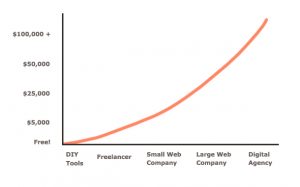If your website is outdated – then you probably realize you need to upgrade it. If you’ve not taken action yet, it’s probably because the mere thought of a website upgrade causes you stress or you’re worried about the cost.
Website Upgrade Stress
Let’s look at the stress factor first. Just knowing a site needs to be upgraded is a stressor – but putting the focus on how an upgraded site could benefit your business will help alleviate the stress. Create a list of “must-have” and “wishlist” functions for a new or upgraded site. Base this list on existing user data (or lack thereof). Employ some basic website traffic services like Google Analytics and get some insights into your existing site’s performance. For a fee, you can use sites like FiveSecondTest to obtain analysis from actual users. This list can help you determine what your site should and should not do, so unnecessary features and functions can be discarded – and new necessary ones considered.
Next, list your social media integrations. Placement of social media content on your site, as well as integration apps that share your content on social media platforms is important. If your site is currently weak on both – know that there are tools to automate social media tasks in an upgraded website.
Website Upgrade Analysis
Examine your existing home page – does it contain the five (5) elements it should?
- Contact information;
- High-quality, responsive images that clearly represent what your business is about;
- Easy navigation and menus with working links;
- Email signup invite or newsletter signup;
- Social media, privacy, and terms of use links.
Does your website load in under 5 seconds? Nothing will drive away potential customers like a slow-loading website. Tools like GTmetrix provide a wealth of information about your site load time, as well as issues that should be addressed and recommendations for optimization.
If your theme (look and feel) is outdated, you are seriously behind the eightball in online terms. Tech-savvy site visitors using a variety of devices expect a website to keep up with changing trends. It is estimated that websites in today’s online environment should be updated after a minimum of two (2) years.
If your site is not responsive – meaning it automatically adjusts for desktop, laptop, tablet or mobile devices – then it is beyond the expiration date. It doesn’t matter how well your old site design has served you – it is time to upgrade.
If your SEO performance is dismal and your bounce rate is high – then it is time to upgrade. A bounce rate higher than 40-60% indicates that you’re doing something wrong. The problem could be content, navigation, overall look and feel, or all of the above. Search engines love fresh, new content so updating your site will generate new crawls and index of your pages. The combination of an awesome new theme, fresh organic content, responsiveness, social shares and inquiries will kickstart your chances of getting noticed.
Website Upgrade Cost
 There are a lot of decisions to be made for a website upgrade, but the decision to upgrade is stressful more often than not because of the cost. Website upgrades take time and cost money, a fact which cannot be denied. There are free options, expensive options – and those in-between. Generally, the price of website upgrades relates directly to the time it takes to do the work. Cost is based on time requirements for design, programming, and communication between client and webmaster. Keep in mind, if you micro-manage a site upgrade and require massive amounts of a webmaster’s time – you will pay for it. Think of the process and cost much like an attorney…you are charged a minimum 1-hour rate for every phone call. Why? Because time (and expertise) is money to a service provider, and spending time explaining every move to a client does not move the project toward completion.
There are a lot of decisions to be made for a website upgrade, but the decision to upgrade is stressful more often than not because of the cost. Website upgrades take time and cost money, a fact which cannot be denied. There are free options, expensive options – and those in-between. Generally, the price of website upgrades relates directly to the time it takes to do the work. Cost is based on time requirements for design, programming, and communication between client and webmaster. Keep in mind, if you micro-manage a site upgrade and require massive amounts of a webmaster’s time – you will pay for it. Think of the process and cost much like an attorney…you are charged a minimum 1-hour rate for every phone call. Why? Because time (and expertise) is money to a service provider, and spending time explaining every move to a client does not move the project toward completion.
While CMS platforms are opensource (free), that doesn’t mean site development is free or cheaper. Platforms such as WordPress allow quick, inexpensive, uncomplicated small websites to be created efficiently – but large, complicated ones that require intense customization can be expensive. The beauty of using WP is the ability for clients to manage even complex websites without having to pay a developer for every change.
If you already use a content management system (CMS), that cost can be considerably less. If your site is so outdated that it isn’t built on a CMS platform, the upgrade will be more complicated – but tools to migrate existing content do exist to lessen the impact. The important issue is to analyze your needs before a website upgrade begins so you can lessen the cost of future upgrades. Positioning your business website to remain updated in the future is a top priority.
EMG specializes in the following areas to help clients orchestrate website upgrades as stress-free as possible:
- building websites that will not require calling a developer for revisions to content;
- utilizing CMS platforms that can be automatically updated for routine patches and security features;
- incorporating features that enhance SEO and performance;
- creating navigation that promotes a positive user-experience;
- preserving existing SEO “juice” to avoid any ranking loss;
- adhering to website standards and best practices to make future updates less complicated or costly;
- conducting website upgrades on a development server until complete, tested, tweaked and ready to launch;
- handling the entire procedure for our clients.
A website that is well-designed and easily updated has a lifespan of 3-5 years, depending on the business and the industry. Afterward, updates are no longer effective and a redesign should be orchestrated. As for cost, while a difference of $2K and $5K cost may seem high – a great site will produce better results and last longer than another average site that puts you back to square one in 2 years or less.

